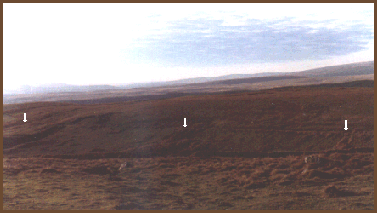
Upper Swansea Valley
The Story of Iron 2
by Len Ley
The Iron Master Richard Parsons was born at Clydach. He lived with the Gough family at first but later moved to his own house. He was reasonably successful at Ynyscedwyn but did little to develop the art of smelting iron. He produced quantities of crude pig iron much of which was sent for ships ballast and some taken by donkey over the Black Mountains to the forge at Llandefaen. He built his own forge at Clydach in 1790, and from then on transported iron by packhorse along the banks of the River Tawe.
The line of the tramway on Cribarth (indicated by arrows) as visible in the 1970's
From the
collection of
the late John Morris

The building of tramroads allowed for easier access to limestone and the completion of the Swansea Valley Canal linking Ynyscedwyn with the lower valley and the port of Swansea and new markets in 1798 meant that from then on, the problem of transportation of heavy materials was effectively overcome.